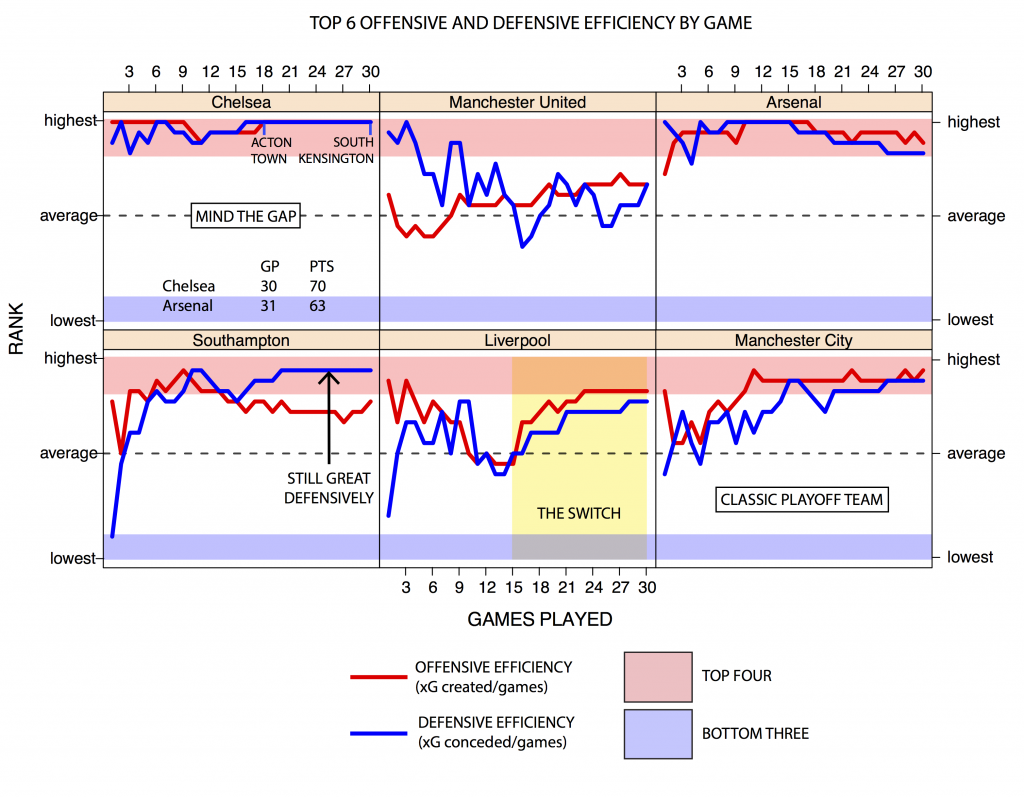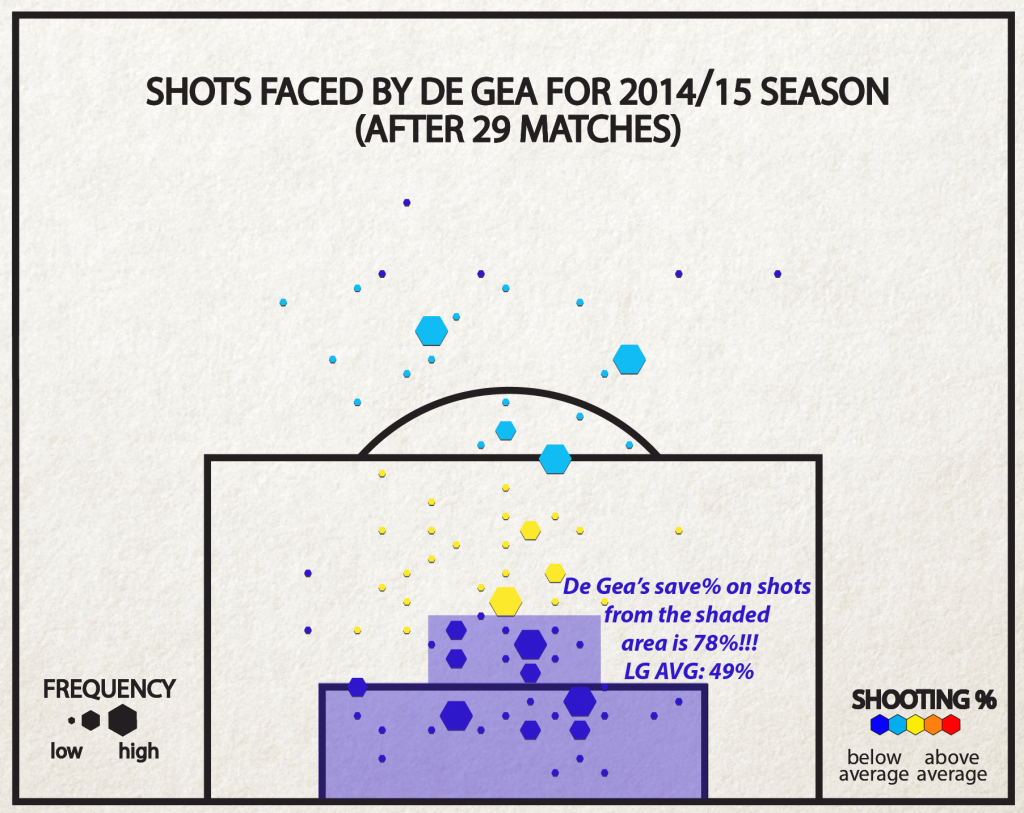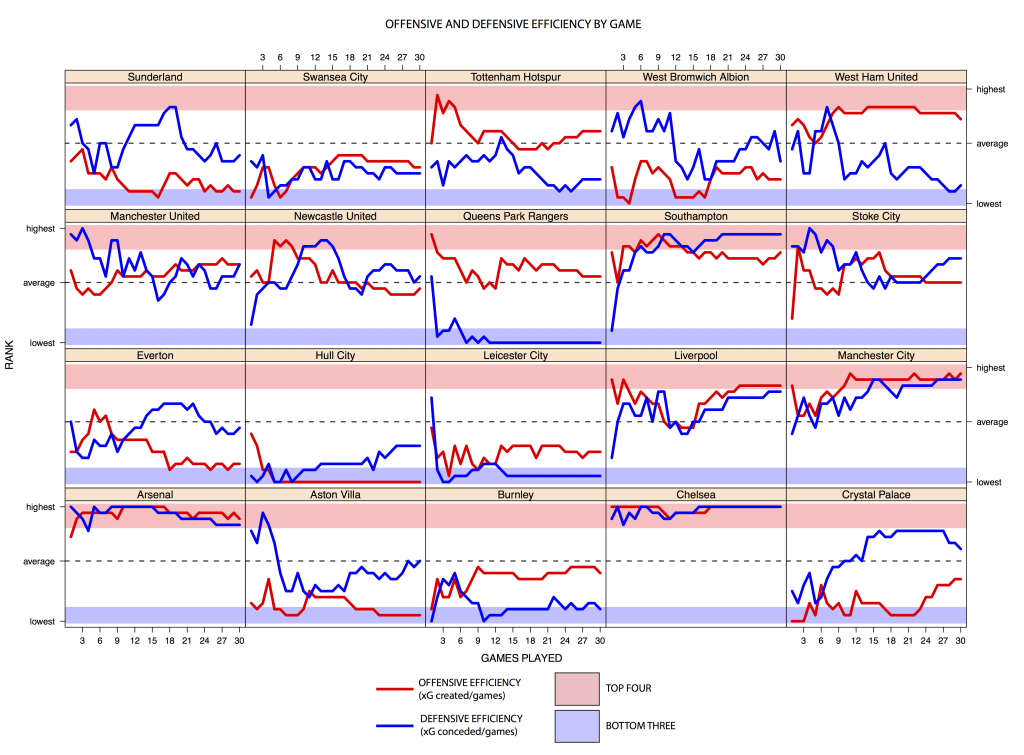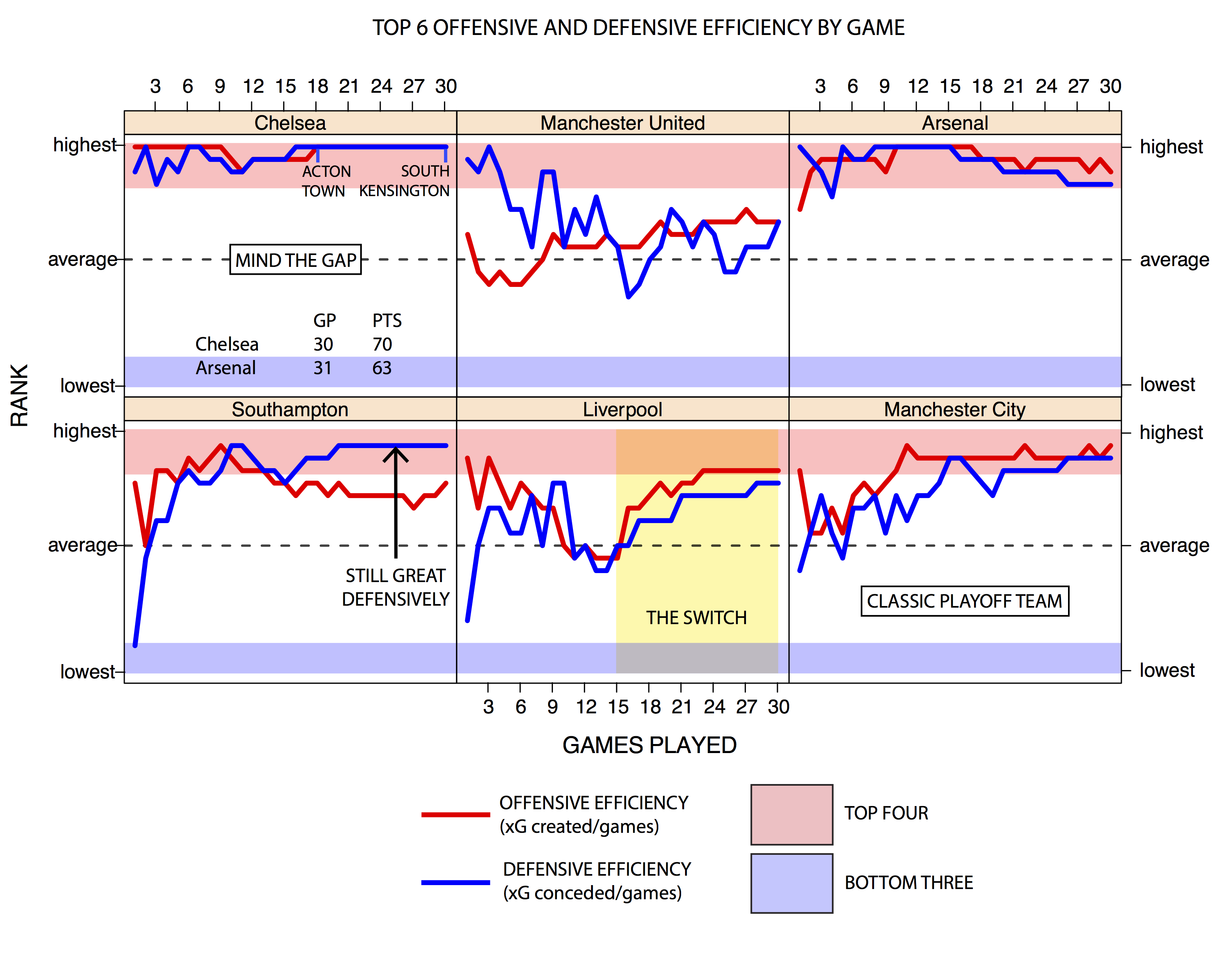As was the case last time, these are offensive and defensive efficiency rankings for the Premier League teams. I’m defining offensive efficiency as xG created, divided by number of games played. So for example, if Man United created 10 xG in 5 games, its offensive efficiency would be 2.0 xG per game. Defensive efficiency is similar, but uses xG conceded instead of xG created. I’ve posted the big xG chart that ranks all the Premier League teams at the bottom, but for today, I’d like to focus on the best six teams of season so far. Thanks again to Michael Caley for providing me data from his ExpG model. So there you go. If you have any questions about my definitions or other things, please feel free to hit me up in the comments section.  Green Shoots Losses to Arsenal and Man United may have slowed Liverpool’s roll, but Brendan Rodgers’ side has re-established itself as a serious force after a sticky start to post-Suarez life. As has been well documented, Brendan Rodgers made a tactical switch mid-season by shifting the creative burden to Philippe Coutinho in a playmaking role behind the striker. I’ll leave the curation of a more detailed narrative to Michaels Caley and Cox, but since Coutinho’s Arrival (yes, capital ‘A’), the Reds’ offense has developed into the shifting, cutting monster that we all hoped was still possible after the Suarez transfer. Liverpool has gone from a middle of the pack offensive efficiency of 1.22 ExpG/game, to a dazzling 1.69 ExpG/game, which comes in just below Chelsea’s league-best mark. You can cut that with all the qualifiers you want, but allow me one of my own - that’s without a fully fit Daniel Sturridge, who was one of the 10 best players in the league last season. The efficiency chart also shows that Liverpool have improved defensively since ‘The Switch”. The change isn’t quite as dramatic as what happened on the offensive end, but the Reds have squirmed their way to respectability. At 1.06 xG conceded/game, they are the midpoint between elite and league average. It will be interesting to see whether Fenway Sports Group (FSG) will delve into the transfer market to bring in some more talent on the defensive end. Lucas is good, but struggles with injuries each season. Emre Can is a talented footballer who has played well at
Green Shoots Losses to Arsenal and Man United may have slowed Liverpool’s roll, but Brendan Rodgers’ side has re-established itself as a serious force after a sticky start to post-Suarez life. As has been well documented, Brendan Rodgers made a tactical switch mid-season by shifting the creative burden to Philippe Coutinho in a playmaking role behind the striker. I’ll leave the curation of a more detailed narrative to Michaels Caley and Cox, but since Coutinho’s Arrival (yes, capital ‘A’), the Reds’ offense has developed into the shifting, cutting monster that we all hoped was still possible after the Suarez transfer. Liverpool has gone from a middle of the pack offensive efficiency of 1.22 ExpG/game, to a dazzling 1.69 ExpG/game, which comes in just below Chelsea’s league-best mark. You can cut that with all the qualifiers you want, but allow me one of my own - that’s without a fully fit Daniel Sturridge, who was one of the 10 best players in the league last season. The efficiency chart also shows that Liverpool have improved defensively since ‘The Switch”. The change isn’t quite as dramatic as what happened on the offensive end, but the Reds have squirmed their way to respectability. At 1.06 xG conceded/game, they are the midpoint between elite and league average. It will be interesting to see whether Fenway Sports Group (FSG) will delve into the transfer market to bring in some more talent on the defensive end. Lucas is good, but struggles with injuries each season. Emre Can is a talented footballer who has played well at left right back, but he got found out against Man United and might be better suited to a midfield role in the long term. There’s work to do, but this team is young, solid on both sides of the ball and has plenty of room to improve. It took a while, but this team has adjusted to life without Suarez and the future looks a lot rosier than it did even a few months ago. That’s why all this Sterling contract stuff sounds like hot air. FSG may have played hardball with Manny Ramirez back in the day, but this isn’t baseball. Football is just different, it’s a team sport and losing your most important player, which is what Raheem Sterling has become for Liverpool, will affect every facet of your team’s play. John Henry has recent, firsthand experience of what that’s like. This season’s reboot cost Liverpool Stevie G’s last chance at a title, Champion’s League qualification and years of Brendan Rodgers’ life! Why oh why would Henry have any interest in doing the same thing next season? King Louis It’s news to no one but your auntie, that Louis van Gaal and Ronald Koeman don’t like each other. This season, Koeman had the chance to deliver a body blow to his fellow Dutchman’s career, but he appears to have missed his opportunity. Think about it for a second. Last summer, van Gaal steered an unfancied Dutch team deep into the World Cup knockout stages. It was great news for the Oranje, but terrible news for the Red Devils, since it meant that Van Gaal took charge at the tail end of the preparation stages for the new season. He inherited a team that wasn’t so much ‘broken’ as not yet constructed. If you imagine Jose Mourinho starting this season at the head of a mutant crew sailing the Black Pearl, then spare a thought for Van Gaal who turned up at the docks ready to set sail, only to find a feverish Ed Woodward pointing excitedly at a bathtub filled with stacks of marginally different, mahogany Captains’ Wheels. By the time King Louis realized what he was working with, the only players available were overpriced and didn’t really fit into the scheme he intended on implementing. So he bought them anyway. For almost the entire season, Southampton has been a better team than Man United. The Saints pair elite defensive efficiency (0.96 xG conceded/game) with above average offensive performance (1.46 xG created/game). That’s good for an xG differential of 0.50 xG/game (1.46 – 0.96), or more than double Man United’s current xG differential of 0.21 xG/game. What we’ve seen unfold over the course this Man United season wasn’t a coaching masterclass, but a testament to the value of top class strikers and goalkeepers. Overtraining led to an injury crisis of biblical proportions and inflexible tactics meant long spells on the bench for some of the team’s most talented players. All season, Van Gaal’s team has been little more than above average on both sides of the ball. Yet with 7 games left, Man United sit comfortably among the Champion’s League places thanks to a sky high PDO (still the highest in the league according to @ObjectiveFooty’s ‘Main Table’). Despite the pedigree of some of their players, the Red Devils are rather Pulisian in the way they try to muck things up. Just like Pulis’ teams, they slow the game down; they don’t mind trading in attacking opportunities for solidity on the defensive end. This tactic works for Pulis, because his teams are usually underdogs. Slowing the pace down condenses the game, and a shorter game means a greater chance of a random outcome (e.g. that the lesser team gets a result). It works for Van Gaal because he’s willing to bet that in a game of few opportunities, his strikers and his goalkeeper will be more clinical in taking their chances than yours. And that is exactly what has happened. Wayne Rooney and Co. have scored 36.9% (again from @ObjectiveFooty) of their shots on target. That’s the best team scoring percentage in the league. Also best in the league is David de Gea’s 75.0% save rate. That’s impressive on it’s own, but things get really crazy when you look at where he’s saving shots from.  Shots on target from the shaded area are normally scored at a 51% clip, yet Man United’s opponents are converting these shots at a meager 22% (6 of 27). A league average keeper could reasonably be expected to concede 13 goals on that many shots from these areas – De Gea has conceded only 6. Clearly this is unsustainable; his save% from these areas close to goal is better than his save% from the other less dangerous areas. But it may not matter… Van Gaal’s men are 8 points clear of the chasing pack and look like a better side each passing week. This summer, King Louis will spend again, but this time, he’ll have time to pick his targets and an uncluttered offseason to mold his team’s identity. Had Southampton managed to clinch a Champions’ League spot, it might have been curtains for Van Gaal, as ownership grew skittish over the terms of team’s lucrative shirt sponsorship. Instead, it’s Koeman looking for answers ahead of Morgan Schneiderlein’s probable departure and, God forbid, the potential burden of Europa League qualification.
Shots on target from the shaded area are normally scored at a 51% clip, yet Man United’s opponents are converting these shots at a meager 22% (6 of 27). A league average keeper could reasonably be expected to concede 13 goals on that many shots from these areas – De Gea has conceded only 6. Clearly this is unsustainable; his save% from these areas close to goal is better than his save% from the other less dangerous areas. But it may not matter… Van Gaal’s men are 8 points clear of the chasing pack and look like a better side each passing week. This summer, King Louis will spend again, but this time, he’ll have time to pick his targets and an uncluttered offseason to mold his team’s identity. Had Southampton managed to clinch a Champions’ League spot, it might have been curtains for Van Gaal, as ownership grew skittish over the terms of team’s lucrative shirt sponsorship. Instead, it’s Koeman looking for answers ahead of Morgan Schneiderlein’s probable departure and, God forbid, the potential burden of Europa League qualification. 
2015
Top 6 Teams in the Premier League (by xG)
By admin
|
April 11, 2015
